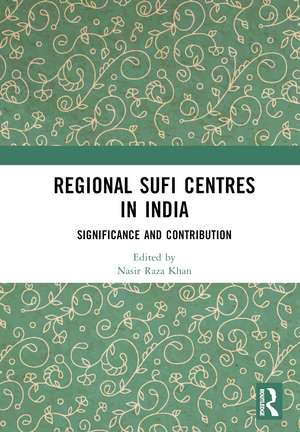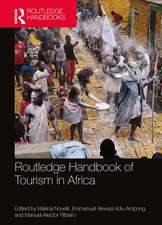Regional Sufi Centres in India: Significance and Contribution
Editat de Nasir Raza Khanen Limba Engleză Hardback – 9 iun 2023
Sufism came to India from its Arabic Turkic and Persian homes, instead of remaining confined to palaces and mosques. It spread out to all over India establishing regional Centres and Dargahs often known by the surnames of the families which sustained it, like Khanqah-e-Niazia, in Bareilly (UP), Khanqah Gesu Daraz in Gulbarga, and Firdausi in Bihar.
The authors of this volume discuss some of the regional Sufi Centres in India and their contribution in the social emancipation of the society.
Print edition not for sale in South Asia (India, Sri Lanka, Nepal, Bangladesh, Pakistan and Bhutan)
| Toate formatele și edițiile | Preț | Express |
|---|---|---|
| Paperback (1) | 309.49 lei 3-5 săpt. | +15.62 lei 7-11 zile |
| Manakin Press – 28 noi 2024 | 309.49 lei 3-5 săpt. | +15.62 lei 7-11 zile |
| Hardback (1) | 1008.86 lei 6-8 săpt. | |
| Manakin Press – 9 iun 2023 | 1008.86 lei 6-8 săpt. |
Preț: 1008.86 lei
Preț vechi: 1230.32 lei
-18% Nou
Puncte Express: 1513
Preț estimativ în valută:
193.07€ • 199.18$ • 163.40£
193.07€ • 199.18$ • 163.40£
Carte tipărită la comandă
Livrare economică 04-18 martie
Preluare comenzi: 021 569.72.76
Specificații
ISBN-13: 9781032508931
ISBN-10: 1032508930
Pagini: 148
Dimensiuni: 174 x 246 x 10 mm
Greutate: 0.7 kg
Ediția:1
Editura: Manakin Press
Colecția Routledge
ISBN-10: 1032508930
Pagini: 148
Dimensiuni: 174 x 246 x 10 mm
Greutate: 0.7 kg
Ediția:1
Editura: Manakin Press
Colecția Routledge
Public țintă
Academic, General, and PostgraduateCuprins
Preface
About the Contributors
Introduction
1. Sufi-Bhakti Saints and their Contributions in the Making of Region in Medieval Rajasthan
Jibraeil
2. Medieval Delhi, Hazrat Nizamuddin Auliya and Fawaidul Fowad
Aleem Ashraf Khan
3. The Concept of Sufism in Sant Darshan Singh’s Urdu Poetry
A.K. Chaturvedi
4. A History and Migration of Naqshbandiya from Central Asia to Aurangabad Deccan
Shaikh Musak Rajjak
5. Reformation and Vernacularization of Sufism in Bengal: Understanding the Formation of ‘Silsila-e-Furfura Sharif’ in West Bengal
Abdul Matin
6. Communal Harmony and the Mystical Thought
Surayia Gull
7. Politics and Piety in Troubled Times: Mirza Mazhar Jan I Janan’s Attitude Towards Other Religions
Abdullah M. Chishti
8. Sufi-Scholarly Impact of ‘Hadrami Sayyids’ In Malabar
Zainul Abid T.
9. Sufi Poet Amir Khusrau: A link between the court and the Khanqah
Saifullah Saifi
10. Sufi Saints and Dargahs of Medieval Jaunpur
Syed Mohammad Amir
Bibliography
Images of Regional Sufi Dargahs in India
Index
About the Contributors
Introduction
1. Sufi-Bhakti Saints and their Contributions in the Making of Region in Medieval Rajasthan
Jibraeil
2. Medieval Delhi, Hazrat Nizamuddin Auliya and Fawaidul Fowad
Aleem Ashraf Khan
3. The Concept of Sufism in Sant Darshan Singh’s Urdu Poetry
A.K. Chaturvedi
4. A History and Migration of Naqshbandiya from Central Asia to Aurangabad Deccan
Shaikh Musak Rajjak
5. Reformation and Vernacularization of Sufism in Bengal: Understanding the Formation of ‘Silsila-e-Furfura Sharif’ in West Bengal
Abdul Matin
6. Communal Harmony and the Mystical Thought
Surayia Gull
7. Politics and Piety in Troubled Times: Mirza Mazhar Jan I Janan’s Attitude Towards Other Religions
Abdullah M. Chishti
8. Sufi-Scholarly Impact of ‘Hadrami Sayyids’ In Malabar
Zainul Abid T.
9. Sufi Poet Amir Khusrau: A link between the court and the Khanqah
Saifullah Saifi
10. Sufi Saints and Dargahs of Medieval Jaunpur
Syed Mohammad Amir
Bibliography
Images of Regional Sufi Dargahs in India
Index
Notă biografică
Nasir Raza Khan (Ph.D.) is Hony. Director of India Arab Cultural Centre, Jamia Millia Islamia, New Delhi, India. He is former visiting professor of ICCR Chair of International Studies, Lebanese American University, Beirut, Lebanon, and former director of the Lal Bahadur Shastri Centre for Indian Culture, Embassy of India, Tashkent, Uzbekistan.
Descriere
The authors of this volume discuss some of the regional Sufi Centres in India and their contribution in the social emancipation of the society.



















